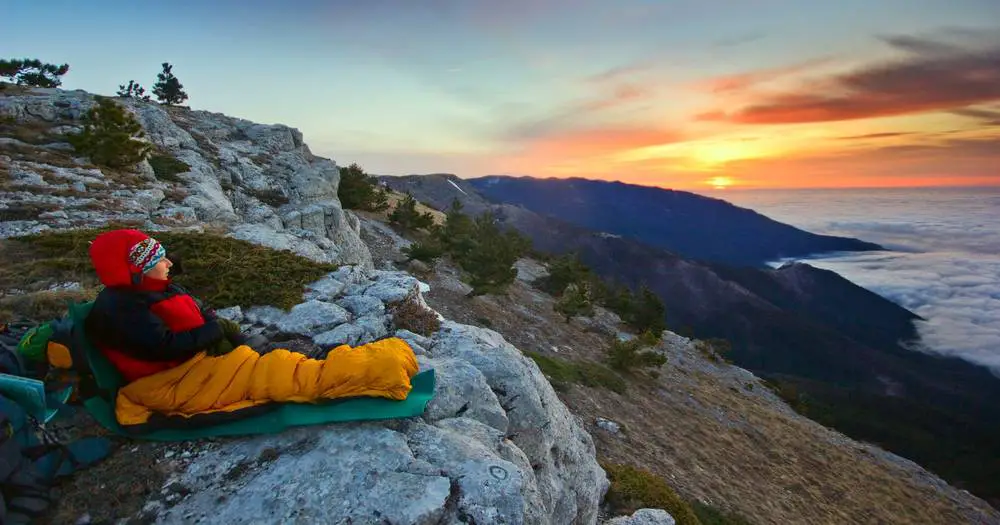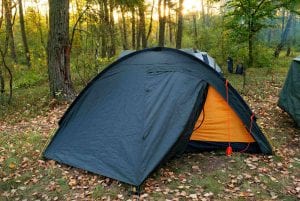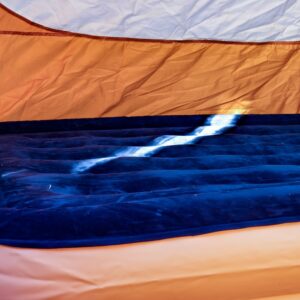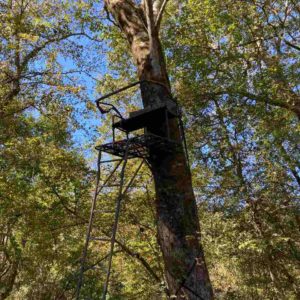
Sometimes, it’s worth thinking outside the box. When you’re packing for a camping trip, it’s tempting just to stuff that trusty tent in your pack because it’s the tried-and-tested solution — but it’s certainly not your only option. From tarps, hammocks and bedrolls right through to makeshift shelters or RVs, there are so many alternatives for sleeping out in the great outdoors.
- The most commonly used tent alternatives are lightweight options like tarps, hammocks and bivy sacks.
- With tools, time, and permission, you could also try building your own shelter from natural materials.
- Sleeping in a vehicle can be a great alternative to camping in a tent — whether you’re living it up in a high-end RV or just slinging a sleeping bag in your truck bed.
Lightweight Tent Alternatives
Most people use a tarp, hammock, or bivy sack because they’re trying to skim down their pack weight. But beyond that, these alternatives offer a fundamentally different experience to camping in a regular tent. If it’s true that sleeping in a tent is like being “indoors in the outdoors,” then some of the options below offer a purer kind of adventure that’s a lot closer to nature.
Tarps
A tarp is pretty much the simplest and most effective tent alternative there is. It’s a rectangle of waterproof fabric (normally synthetic but sometimes canvas) with attachment points for cords or bungees. You can string it between two trees to make a simple ridged shelter, or use sticks or poles as supports. Check out a few different configurations here.
A tarp shelter is usually open to the elements at the sides, but that can be one of the nicest things about them. They’ll give you some rain protection but otherwise you’re out in the night air like any other forest dweller.
The lines between tents and tarps can get a little blurry, and in fact a “tarp tent” is a recognized thing. Often constructed in silnylon or cuben fiber, these are hugely popular with the ultralight crowd, and are essentially a shaped rain fly that you peg out using a hiking pole as a central support. Tarp tents will often have a zipped door but you’ll need to bring a separate groundsheet if you want that extra layer of protection under your sleeping pad.
Hammocks
Hammock campers are the great evangelists of the outdoor world. And they do have a point — hammocks are lightweight, comfortable and quick to put up. But while a die-hard hammocker will try and persuade you that only a total imbecile would be a “ground-dweller” when they could be a “tree-dweller,” the truth is that hammocks and tents both have their place.
It sounds obvious, but hammocks aren’t the best alternative to tents in treeless upland or mountain landscapes. Take one into a forest, however, and you’re way ahead of the tent campers. While they’re busy scouring the forest floor for the tiniest patch of flat ground that’s not wormed through with tree roots, you can have your hammock slung between two trunks in no time.
You’re best off using a hammock that’s specifically designed for camping, rather than the cheap Pirates of the Caribbean-style fishing net thing that you’ve got strung up in the backyard. Camping hammocks are lightweight and durable, but more importantly they’re also windproof and breathable — and you won’t wake up in the morning with a diamond pattern on your face.
Unless you’re camping in really mild conditions, a hammock on its own won’t be enough to keep you warm and dry. Most hammock campers will use some sort of insulated liner to stop the cold creeping in from underneath, with a simple tarp rigged up over the top for rain protection. A bug net is also usually a good idea if you don’t fancy being food for flying things.
Bivy Sacks
There’s some misunderstanding online about what a “bivy sack” or “bivvy bag” actually is. It’s essentially just a human-sized waterproof bag that you can put your sleeping pad and sleeping bag inside, then crawl into.
The cheapest bivvies are literally just like heavy-duty plastic trash sacks, while more expensive ones will tend to be made of lightweight synthetics that offer some degree of breathability. You can also get heritage-style canvas bivy sacks, which are known as “swags” in Australia.
A bivy sack isn’t generally breathable enough for you to put your head inside, so your face will be open to the elements — though there’s usually a drawcord that you can tighten right up to keep the rain out. Some more sophisticated models are fully sealed and feature a couple of arched mini-poles to create a sort of micro-tent over your torso and head, but these aren’t true bivvy bags. They’re more like a kind of hybrid between a bivvy and a tent, and in many cases the weight and packed size aren’t far off those of an ultralight tent.
Bivvies are not particularly comfortable. There’s no insulation, you’re sleeping on the cold ground, and condensation can be a real pain. This is no-frills camping at its most basic, but it can also feel incredibly liberating to sleep free under the open sky.
Cowboy camping
“Cowboy camping” is like bivvying but without the protection of a waterproof bag. Normally you’d use a bedroll consisting of an air mattress and a sleeping bag, but some cowboy campers like to make their own “mattress” out of leaves or dry grass — and they might choose to switch the sleeping bag for an old-school camp blanket.
If you’re not quite ready to go full cow-puncher, you might consider bringing a lightweight backpacking cot. This will keep you off the ground while still letting you enjoy the feel of the open air.
Clearly, cowboy camping works best in warm, dry places without too many nocturnal critters and bugs, but pick the right season and a soft patch of ground, and it’s pretty much the loveliest way to sleep under the stars.
Improvised Shelters
Mother Nature provides. Given a little time and the right tools, you can put together a shelter from the natural materials around you, whether that’s saplings, tree branches, dead leaves, or even just snow.
Building your own shelter for the night is an incredibly satisfying camping experience, but before you start living your best caveman life, there are a few tedious modern constraints to consider.
First, any forest you’re camping in will belong to someone, so you can’t just go full Woody Woodpecker and start felling small trees to make shelters out of. That said, if you’re able to contact whoever owns the property, they may not mind you thinning out some of the self-seeded saplings. In fact, they may even encourage it — but the key is to ask first.
Second, unless you’ve been given explicit permission to leave your shelter intact, you should always demolish it when you leave. Apart from anything else, there’s something quite pleasing about scattering your camp and leaving no trace you were ever there.
Tunnel Shelters
The easiest forest shelter to build is a tunnel. Just set up a pair of crossed sticks to make a triangle shape, repeat a couple more times, connect them with a makeshift ridge pole, then stack loads of leafy boughs lengthways along the sides to provide insulation.
You’ll end up with a kind of scruffy-looking doghouse that can be surprisingly warm and comfortable if you’ve got a decent sleeping bag and pad — so long as you don’t mind sharing with a creepy crawly or two.
Lean-to Shelters
An open-sided lean-to is the most classic and instantly recognizable forest shelter, but they take more work to build than you’d think. It’s best to look up some expert advice online in advance, and to leave yourself several hours the first time you try it. Combine it with a cozy campfire for that ultimate frontier feeling.
Snow Shelters
Not for the faint-hearted, this one, but sleeping in a snow-hole is an amazing and sometimes surprising experience. It’s a hell of a lot warmer than being above ground in a tent, and deliciously quiet even if there’s a storm shrieking outside.
For a stable shelter that’ll withstand winds and fresh snow dumps, the key is to get yourself dug deep enough into the snow — and for a group shelter you can expect to spend all afternoon and a lot of effort getting it hollowed out. The normal design is a low crawl tunnel into the side of a hard-packed drift, opening out into a more spacious sleeping chamber.
Constructing a snow cave is a skill that takes some time to get the hang of, so either practise when you’ve got alternative shelter right nearby, or tag along with someone more experienced who’s done it before.
Vehicle-Based Tent Alternatives
Is it really camping if you’re sleeping in a vehicle? Well, we’d say it kinda depends. Sure, a high-end motorhome can have all the amenities of a plush apartment, but then a cabin tent can also be pretty luxurious compared to life on the road in a Summer-of-Love-style VW Kombi van. It’s all relative.
RVs
Recreational vehicles exist across a vast spectrum of size and comfort, from the simplest little shoeboxes-on-wheels (preferably painted up with garish flowers or flames) to massive Winnebagos that cost hundreds of thousands of dollars and are fitted out like luxury hotel rooms with solar panels and fireplaces.
Each different type of recreational vehicle has its benefits. Bigger RVs are likely to offer more room and comfort — especially for families with kids — but they’re less practical and harder to handle on the highway. You’ll probably need to hunt down proper RV parks each night, and even parking up at a store to get supplies can be tricky.
Smaller vans for two adults are great fun, easy to drive, and can fit just about anywhere — but you won’t get much in the way of home comforts and you’re going to have to be pretty strategic about bathrooms.
Travel Trailers
Trailers are sort of like an RV that you pull behind your truck. As with RVs, they range from tiny teardrop trailers where you have to crawl in through a rear hatch, through to great big gleaming Airstreams with more space and amenities. You can even get tent trailers, which pack down into a compact trailer but open out into a roomy cabin-on-wheels when you reach your destination.
Travel trailers are a comfortable way to rest up on the move, but they’ll normally require the facilities of commercial campgrounds — like water and electric hook-ups, and disposal points for bathroom waste.
Towing is also rather a skill in itself — especially reversing. You’ll probably want to get in a bit of practice (or tuition from a more experienced driver) before you hit the highway.
Rooftop Tents and Awnings
An increasingly popular option these days is a purpose-built rooftop tent mounted on the top of your truck. These tents are huge in the 4WD truck modding and overlanding world — and it’s easy to see why, since they give you all the perks of a roomy trailer tent, but in a package that you can take off-road down the roughest dirt tracks. A rooftop tent is usually quick and simple to pop up, and packs away into a roof-mounted box when it’s not in use.
Another option if you’re fitting out a truck for overlanding is an awning. Normally mounted on the side of the truck, this is a sort of sun/rain shade that opens out like a fan to give you an outdoor dining area. In milder conditions, you can stick a camping cot under it and enjoy a night in the open air.
Sleeping in Your Car or Truck Bed
Celebrated in a whole lot of country songs over the years, sleeping in a car or pickup truck bed is a decent tent alternative in a pinch, and can even be quite comfortable if your vehicle is roomy enough. If you’re planning to do it reasonably often, then you might want to put some thought into how you can make your car camping cozier.
For a pickup, you can get truck bed canopies or even truck bed tents, while sleeping in most cars can be made a hell of a lot more comfortable by putting the seats down and adding mattresses or blankets. You’ve also got the added perk of being able to play Willie Nelson songs on the car stereo as you drift off — just don’t drain the battery…
FAQs
What Can I Use Instead of a Tent?
Lightweight hikers often favor simple shelters like tarps and hammocks as an alternative to tents, or you could even sleep under the stars using a bedroll or bivy sack.
How Can I Go Camping Without a Tent?
In really mild weather, you might not need a tent at all, but if there’s any chance of rain then a simple tarp or waterproof bivy sack will keep you dry.
What Alternative Camping Shelters Are There?
The most popular alternative camping shelter is a camping hammock with a tarp rigged over the top to keep the rain off.
What’s a Good Tent Alternative for a Wedding?
If you’re attending a camping wedding but don’t fancy sleeping in a tent, an RV or tent trailer can be a great alternative — and might just help keep your smartest clothes mud-free.





